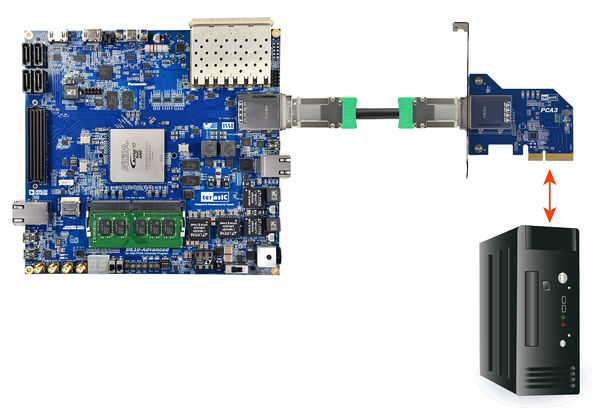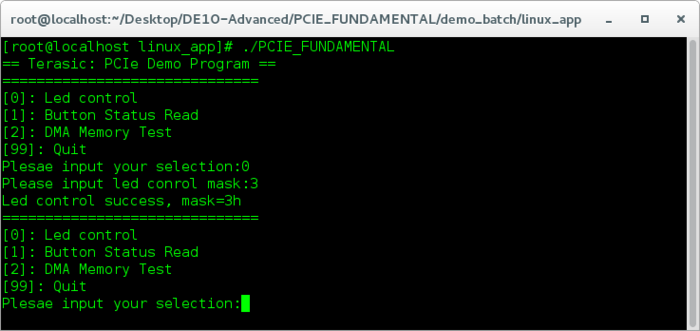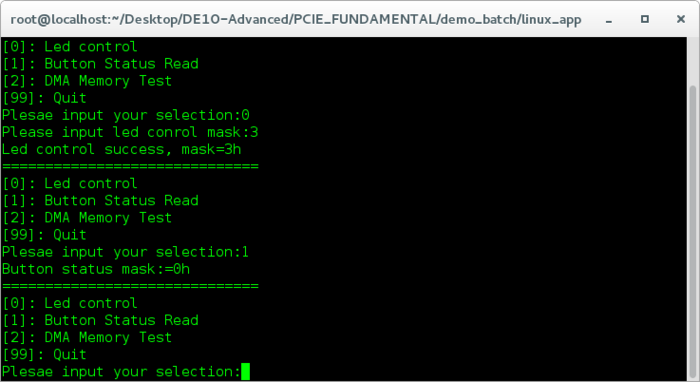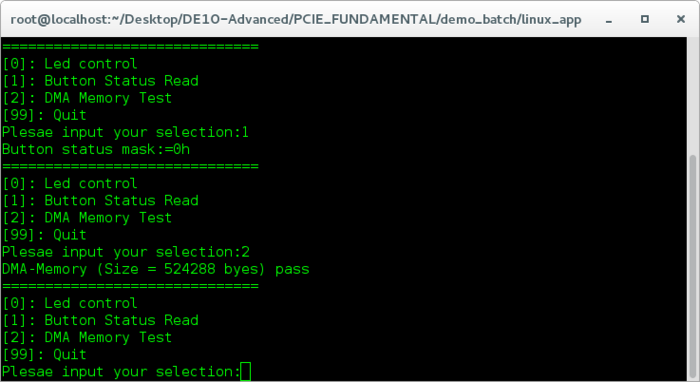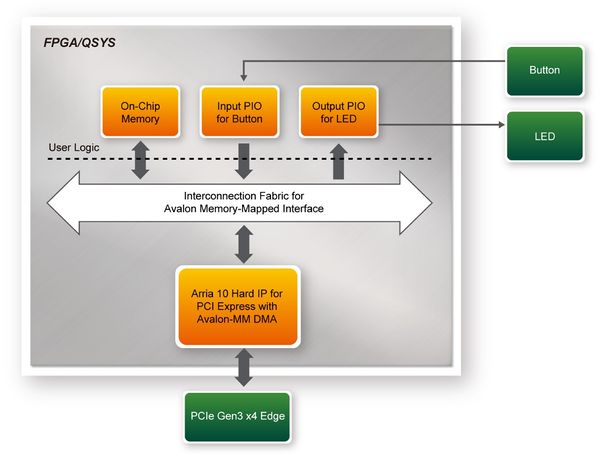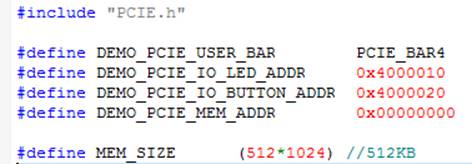DE10-Advanced revC demo: PCIe Reference Design - Fundamental Linux
From Terasic Wiki
(→Demonstration Setup) |
(→Demonstration Setup) |
||
| (11 intermediate revisions not shown) | |||
| Line 15: | Line 15: | ||
=Demonstration Setup= | =Demonstration Setup= | ||
| - | # Install the FPGA board on your PC as shown in [[#Figure83| | + | # Install the FPGA board on your PC as shown in [[#Figure83|Figure1-1]]. |
| + | #:[[File:De10-advanced revc FPGA board connect to PC.jpg|600px]] | ||
| + | #: | ||
| + | #:::::'''Figure 1-1 FPGA board connect to PC''' | ||
# Open a terminal and use "cd" command to goto "CDROM/Demonstrations/PCIe_Fundamental/demo_batch". | # Open a terminal and use "cd" command to goto "CDROM/Demonstrations/PCIe_Fundamental/demo_batch". | ||
# Set QUARTUS_ROOTDIR variable pointing to the Quartus installation path. Set QUARTUS_ROOTDIR variable by tying the following commands in terminal. Replace /home/centos/intelFPGA/18.0/quartus to your quartus installation path. | # Set QUARTUS_ROOTDIR variable pointing to the Quartus installation path. Set QUARTUS_ROOTDIR variable by tying the following commands in terminal. Replace /home/centos/intelFPGA/18.0/quartus to your quartus installation path. | ||
| Line 26: | Line 29: | ||
#: | #: | ||
#:[[Image: DE10-Advanced_revC_PCIE_pic_34.png|600px]]. | #:[[Image: DE10-Advanced_revC_PCIE_pic_34.png|600px]]. | ||
| - | #Goto linux_app folder, execute PCIE_FUNDAMENTAL. A menu will appear as shown in Figure | + | #Goto linux_app folder, execute PCIE_FUNDAMENTAL. A menu will appear as shown in Figure 1-2. |
#: | #: | ||
#:[[Image: DE10-Advanced_revC_PCIE_pic_35.png|700px]] | #:[[Image: DE10-Advanced_revC_PCIE_pic_35.png|700px]] | ||
| - | #:::::'''Figure | + | #:::::'''Figure 1-2 Screenshot of Program Menu''' |
| - | # Type 0 followed by a ENTER key to select Led Control item, then input 3 (hex 0x03) will make all led on as shown in [[#Figure86|Figure | + | # Type 0 followed by a ENTER key to select Led Control item, then input 3 (hex 0x03) will make all led on as shown in [[#Figure86|Figure 1-3]]. If input 0 (hex 0x00), all led will be turn off. |
#: | #: | ||
#:[[Image: DE10-Advanced_revC_PCIE_pic_36.png|700px]] | #:[[Image: DE10-Advanced_revC_PCIE_pic_36.png|700px]] | ||
| - | #:'''Figure | + | #::::::'''Figure 1-3 Screenshot of LED Control''' |
| - | #Type 1 followed by an ENTER key to select Button Status Read item. The button status will be report as shown in [[#Figure87|Figure | + | #Type 1 followed by an ENTER key to select Button Status Read item. The button status will be report as shown in [[#Figure87|Figure 1-4]]. |
#:[[Image: DE10-Advanced_revC_PCIE_pic_37.png|700px]] | #:[[Image: DE10-Advanced_revC_PCIE_pic_37.png|700px]] | ||
| - | #:::::'''Figure | + | #:::::'''Figure 1-4 Screenshot of Button Status Report''' |
| - | # Type 2 followed by an ENTER key to select DMA Testing item. The DMA test result will be report as shown in [[#Figure88|Figure | + | # Type 2 followed by an ENTER key to select DMA Testing item. The DMA test result will be report as shown in [[#Figure88|Figure 1-5]]. |
#:[[Image: DE10-Advanced_revC_PCIE_pic_38.png|700px]] | #:[[Image: DE10-Advanced_revC_PCIE_pic_38.png|700px]] | ||
| - | #::::'''Figure | + | #::::::'''Figure 1-5 Screenshot of DMA Memory Test Result''' |
# Type 99 followed by an ENTER key to exit this test program | # Type 99 followed by an ENTER key to exit this test program | ||
| Line 47: | Line 50: | ||
* GNU Compiler Collection, Version 4.8 is recommend | * GNU Compiler Collection, Version 4.8 is recommend | ||
| - | + | =Demonstration Source Code Location= | |
* Quartus Project: Demonstrations/PCIe_Fundamental | * Quartus Project: Demonstrations/PCIe_Fundamental | ||
* C++ Project: Demonstrations/PCIe_SW_KIT/Linux/PCIE_FUNDAMENTAL | * C++ Project: Demonstrations/PCIe_SW_KIT/Linux/PCIE_FUNDAMENTAL | ||
| - | + | =FPGA Application Design= | |
| - | + | ||
| - | + | ||
[[#Figure89|Figure 8-9]] shows the system block diagram in the FPGA system. In the Qsys, Altera PIO controller is used to control the LED and monitor the Button Status, and the On-Chip memory is used for performing DMA testing. The PIO controllers and the On-Chip memory are connected to the PCI Express Hard IP controller through the Memory-Mapped Interface. | [[#Figure89|Figure 8-9]] shows the system block diagram in the FPGA system. In the Qsys, Altera PIO controller is used to control the LED and monitor the Button Status, and the On-Chip memory is used for performing DMA testing. The PIO controllers and the On-Chip memory are connected to the PCI Express Hard IP controller through the Memory-Mapped Interface. | ||
| - | + | [[Image: DE10-Advanced_revC_PCIE_pic_39.jpg|600px]] | |
| + | :::::'''Figure 8-9 Hardware block diagram of the PCIe reference design''' | ||
| - | + | =Linux Based Application Software Design= | |
| + | The application software project is built by GNU Toolchain. The project includes the following major files:</div> | ||
| - | + | :{| class="wikitable" | |
| - | + | ||
| - | + | ||
| - | {| | + | |
| - | + | ||
| - | + | ||
| - | + | ||
| - | + | ||
| - | + | ||
| - | + | ||
| - | + | ||
| - | + | ||
| - | + | ||
| - | + | ||
| - | + | ||
| - | + | ||
| - | + | ||
| - | + | ||
|- | |- | ||
| + | !NAME !!Description | ||
| + | |- | ||
| + | |PCIE_FUNDAMENTAL.cpp | ||
| + | ||Main program | ||
| + | |- | ||
| + | |PCIE.c | ||
| + | | rowspan="2"| Implement dynamically load for TERAISC_PCIE_AVMM.DLL | ||
| + | |- | ||
| + | |PCIE.h | ||
| + | |- | ||
| + | |TERASIC_PCIE_AVMM.h | ||
| + | ||SDK library file, defines constant and data structure | ||
|} | |} | ||
| + | |||
<div style="color:#404040;">The main program PCIE_FUNDAMENTAL.cpp includes the header file "PCIE.h" and defines the controller address according to the FPGA design.</div> | <div style="color:#404040;">The main program PCIE_FUNDAMENTAL.cpp includes the header file "PCIE.h" and defines the controller address according to the FPGA design.</div> | ||
| - | + | [[Image: DE10-Advanced_revC_PCIE_pic_40.jpg|500px]] | |
| - | + | The base address of BUTTON and LED controllers are 0x4000010 and 0x4000020 based on PCIE_BAR4, in respectively. The on-chip memory base address is 0x00000000 relative to the DMA controller. | |
| + | Before accessing the FPGA through PCI Express, the application first calls PCIE_Load to dynamically load the terasic_pcie_qsys.so. Then, it call PCIE_Open to open the PCI Express driver. The constant DEFAULT_PCIE_VID and DEFAULT_PCIE_DID used in PCIE_Open are defined in TERASIC_PCIE_AVMM.h. If developer change the Vendor ID and Device ID and PCI Express IP, they also need to change the ID value define in TERASIC_PCIE_AVMM.h. If the return value of PCIE_Open is zero, it means the driver cannot be accessed successfully. In this case, please make sure: | ||
| - | + | * The FPGA is configured with the associated bit-stream file and the host is rebooted. | |
* The PCI express driver is loaded successfully. | * The PCI express driver is loaded successfully. | ||
| Line 97: | Line 97: | ||
| - | + | [[Image: DE10-Advanced_revC_PCIE_pic_41.jpg|800px]] | |
| - | + | ||
| - | + | ||
| - | + | ||
| - | + | ||
| - | + | ||
<div style="color:#404040;">The button status query is implemented by calling the '''PCIE_Read32''' API, as shown below:</div> | <div style="color:#404040;">The button status query is implemented by calling the '''PCIE_Read32''' API, as shown below:</div> | ||
| - | + | [[Image: DE10-Advanced_revC_PCIE_pic_42.jpg|700px]] | |
| - | + | ||
| - | + | ||
| - | + | ||
| - | + | ||
<div style="color:#404040;">The memory-mapped memory read and write test is implemented by '''PCIE_DmaWrite''' and '''PCIE_DmaRead''' API, as shown below:</div> | <div style="color:#404040;">The memory-mapped memory read and write test is implemented by '''PCIE_DmaWrite''' and '''PCIE_DmaRead''' API, as shown below:</div> | ||
| + | |||
| + | [[Image: DE10-Advanced_revC_PCIE_pic_18.png|600px]] | ||
| + | |||
| + | '''[[DE10_Advance_revC_demo: PCI Express Design for Linux |Back]]''' | ||
Latest revision as of 10:46, 31 August 2018
Contents |
Demonstration Files Location
The demo file is located in the batch folder: CDROM/Demonstrations/PCIe_Fundamental/demo_batch
The folder includes following files:
- FPGA Configuration File: PCIe_Fundamental.sof
- Download Batch file: test.sh
- Linux Application Software folder : linux_app, includes
- PCIE_FUNDAMENTAL
- terasic_pcie_qsys.so
Demonstration Setup
- Install the FPGA board on your PC as shown in Figure1-1.
- Open a terminal and use "cd" command to goto "CDROM/Demonstrations/PCIe_Fundamental/demo_batch".
- Set QUARTUS_ROOTDIR variable pointing to the Quartus installation path. Set QUARTUS_ROOTDIR variable by tying the following commands in terminal. Replace /home/centos/intelFPGA/18.0/quartus to your quartus installation path.
- export QUARTUS_ROOTDIR=/home/centos/intelFPGA/18.0/quartus
- Execute "sudo -E sh test.sh" command to configure the FPGA
- Restart Linux
- Install PCIe driver. The driver is located in the folder: CDROM/Demonstration/PCIe_SW_KIT/Linux/PCIe_Driver.
- Type “ls –l /dev/altera_pcie*” to make sure the Linux has detected the FPGA Board. If the FPGA board is detected, developers can find the /dev/altera_pcieX(where X is 0~255) in Linux file system as shown below.
- Goto linux_app folder, execute PCIE_FUNDAMENTAL. A menu will appear as shown in Figure 1-2.
- Type 0 followed by a ENTER key to select Led Control item, then input 3 (hex 0x03) will make all led on as shown in Figure 1-3. If input 0 (hex 0x00), all led will be turn off.
- Type 1 followed by an ENTER key to select Button Status Read item. The button status will be report as shown in Figure 1-4.
- Type 2 followed by an ENTER key to select DMA Testing item. The DMA test result will be report as shown in Figure 1-5.
- Type 99 followed by an ENTER key to exit this test program
Development Tools
- Quartus Prime 18.0 Standard Edition
- GNU Compiler Collection, Version 4.8 is recommend
Demonstration Source Code Location
- Quartus Project: Demonstrations/PCIe_Fundamental
- C++ Project: Demonstrations/PCIe_SW_KIT/Linux/PCIE_FUNDAMENTAL
FPGA Application Design
Figure 8-9 shows the system block diagram in the FPGA system. In the Qsys, Altera PIO controller is used to control the LED and monitor the Button Status, and the On-Chip memory is used for performing DMA testing. The PIO controllers and the On-Chip memory are connected to the PCI Express Hard IP controller through the Memory-Mapped Interface.
- Figure 8-9 Hardware block diagram of the PCIe reference design
Linux Based Application Software Design
The application software project is built by GNU Toolchain. The project includes the following major files:</div>
NAME Description PCIE_FUNDAMENTAL.cpp Main program PCIE.c Implement dynamically load for TERAISC_PCIE_AVMM.DLL PCIE.h TERASIC_PCIE_AVMM.h SDK library file, defines constant and data structure
The base address of BUTTON and LED controllers are 0x4000010 and 0x4000020 based on PCIE_BAR4, in respectively. The on-chip memory base address is 0x00000000 relative to the DMA controller.
Before accessing the FPGA through PCI Express, the application first calls PCIE_Load to dynamically load the terasic_pcie_qsys.so. Then, it call PCIE_Open to open the PCI Express driver. The constant DEFAULT_PCIE_VID and DEFAULT_PCIE_DID used in PCIE_Open are defined in TERASIC_PCIE_AVMM.h. If developer change the Vendor ID and Device ID and PCI Express IP, they also need to change the ID value define in TERASIC_PCIE_AVMM.h. If the return value of PCIE_Open is zero, it means the driver cannot be accessed successfully. In this case, please make sure:
- The FPGA is configured with the associated bit-stream file and the host is rebooted.
- The PCI express driver is loaded successfully.
